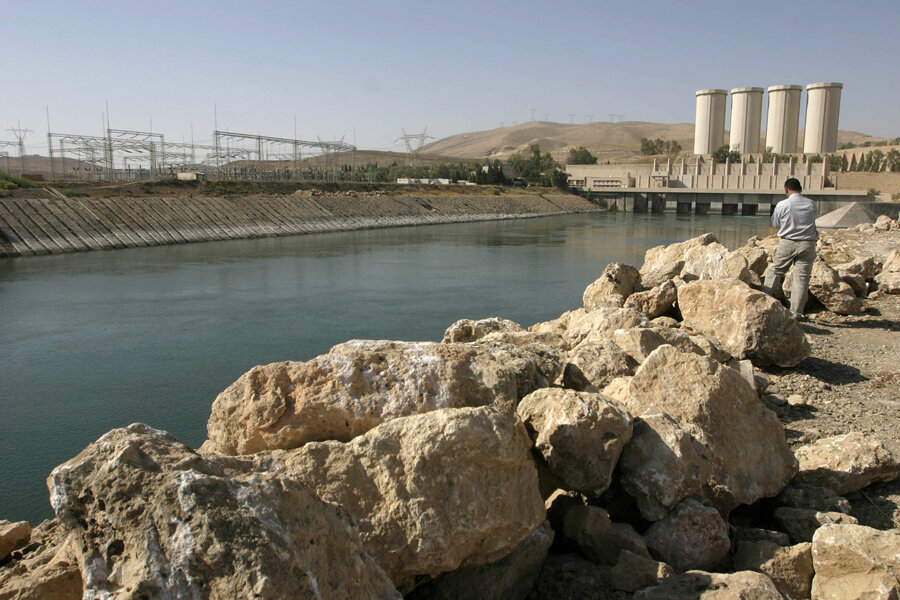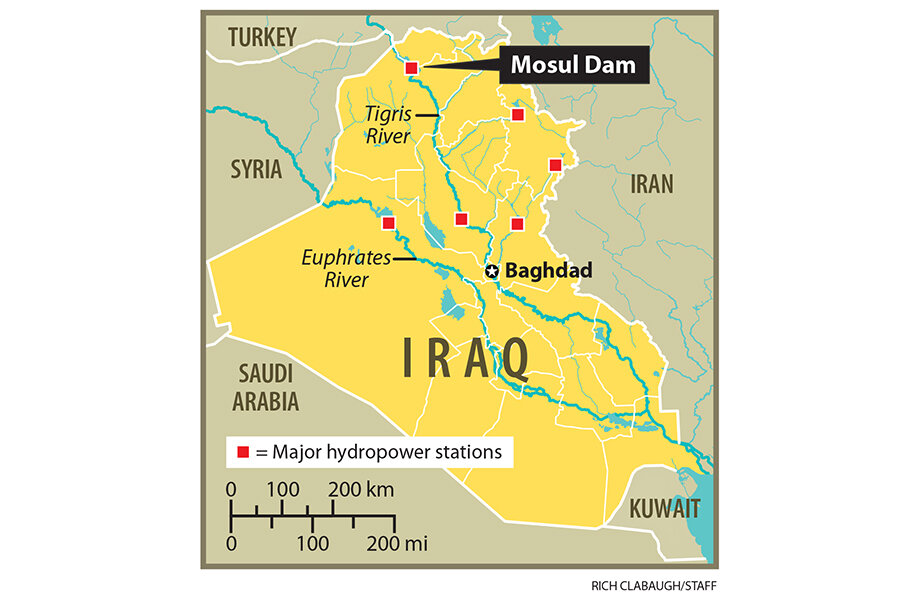Three things to know about Iraq's Mosul Dam
Loading...
With the aid of US airstrikes, Kurdish peshmerga fighters seized control Monday of Mosul Dam, which had been held by the Sunni militant Islamic State (IS). Control of the dam is essential to Iraq’s energy and water resources; the United Nations considers it the “most important hydropower station” in the country.
As the Monitor reported, IS has targeted key energy infrastructure in Iraq, including oil fields and water resources, as it expands its territory in Iraq and Syria.
In April, IS fighters captured the Nuaimiyah Dam in Fallujah and cut off water supplies flowing south to a primarily Shiite population. But a UN news agency reported that “the shutdown also triggered a surge into the Abu Ghraib irrigation channel, causing widespread flooding in an area that is mostly inhabited by Sunnis.” The UN's special representative for Iraq said the damage included the displacement of more than 12,000 families and the flooding of "hundreds of houses and at least four schools."
In recent weeks, IS has tried and failed to gain control of Haditha Dam, the country’s second largest, which provides power to Baghdad.
Here are three key things to know about Mosul Dam and why it matters to Iraq and the region.
1. It used to be called Saddam Dam
Former president Saddam Hussein ordered its construction shortly after coming to power. Construction of the hydroelectric dam began in 1980 and was completed in 1984.
The dam supplies power to the national grid and has the capacity to generate 1,050 megawatts of electricity. A March 2014 UN report put the plant’s available capacity at 470 megawatts.
2. It's the largest dam in Iraq
The dam is also the Middle East’s fourth largest in terms of reservoir capacity. It is located in a valley approximately 45 miles north of Mosul on the Tigris River. According to the BBC, the dam holds more than 12 billion cubic meters of water, which is used for agriculture and energy generation. IS’s dam capture in Fallujah disrupted the agriculture sector and damaged crops there.
Approximately 85 percent of Iraq's water resources are used for agriculture, and many low-income families depend on irrigation. In recent years, farmers have planted more fruits and vegetables in place of traditional crops such as rice and tobacco, in part because of desertification and droughts.
3. It's unstable and could trigger a massive flood
The dam was built on top of unstable ground that included soluble gypsum. Its structural deficiencies were exposed during construction; engineers have since managed to fix the foundations with cement injections and grouting, but this has created sinkholes.
In 2007, the US Army Corps of Engineers raised alarm over Mosul, calling it the “most dangerous dam in the world” due to the “internal erosion potential of the foundation.”
US military commander Gen. David Petraeus and US Ambassador Ryan Crocker wrote to then-Prime Minister Nouri al-Maliki warning about the danger the dam posed:
A catastrophic failure of the Mosul Dam would result in flooding along the Tigris river all the way to Baghdad. Assuming a worst-case scenario, an instantaneous failure of Mosul Dam filled to its maximum operating level could result in a flood wave 20 meters deep at the city of Mosul, which would result in a significant loss of life and property.
Should the dam collapse, the resulting flood could result in the deaths of as many as 500,000 people, according to US estimates. The Iraqi government disagreed at the time with the US assessment, saying, “These reports are not accurate and are totally untrue.”









